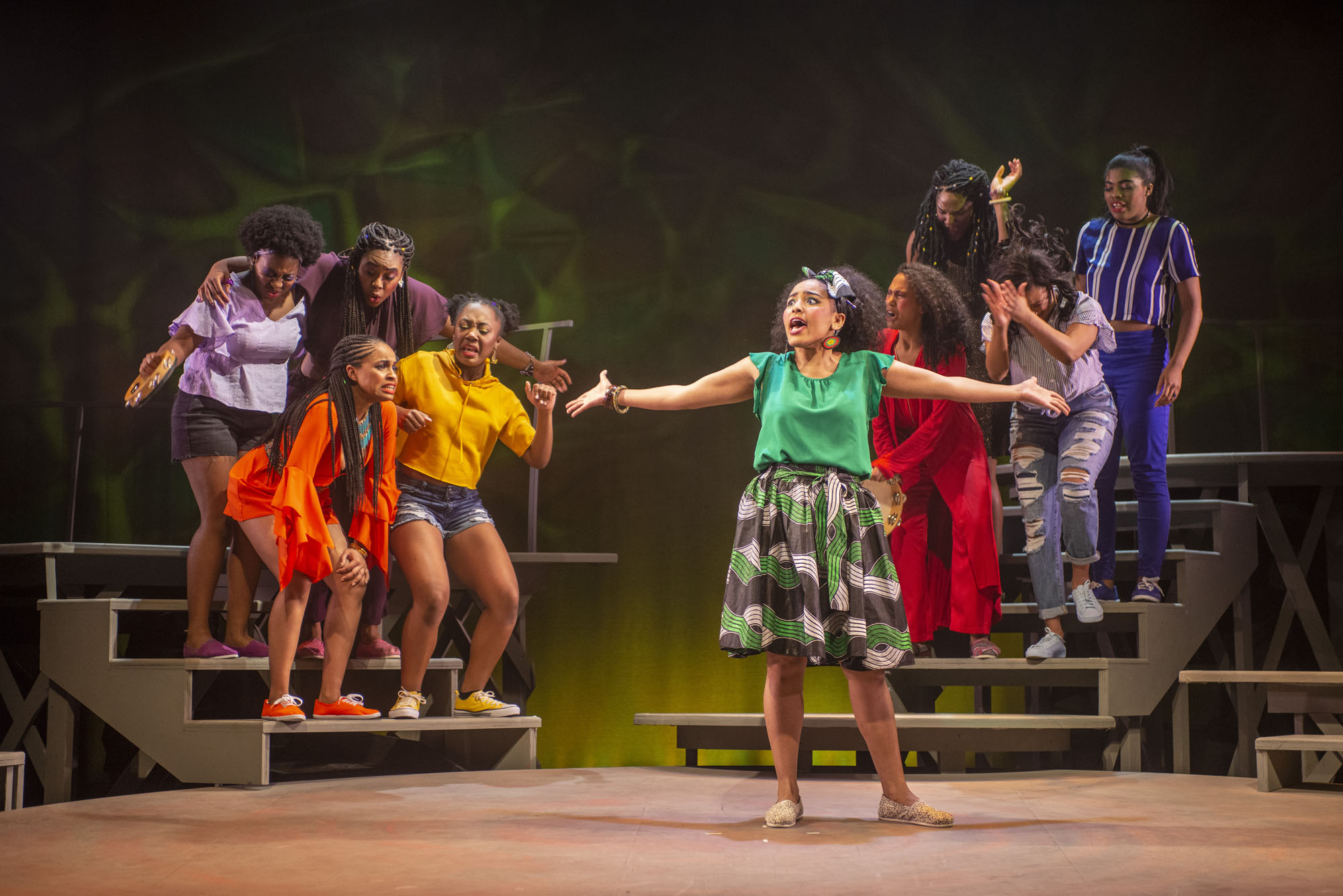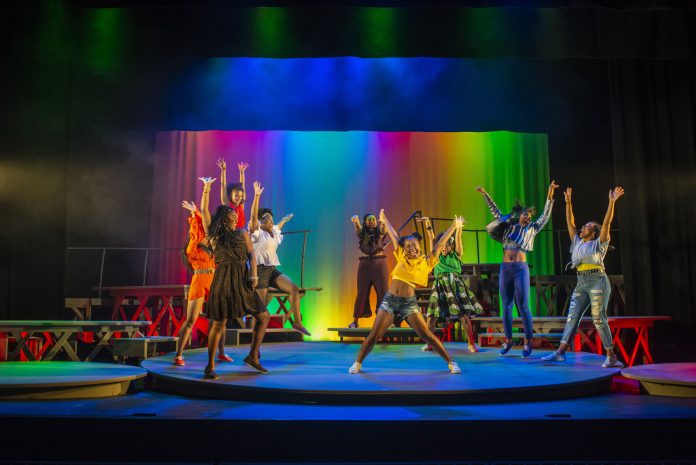When the lights come down on Ntozake Shange’s for colored girls who have considered suicide/when the rainbow is enuf, the audience is already standing. They’re standing and crying and whooping and clapping as if they’ll never clap again, and maybe they won’t – not for something like this, at least. Not for something this daring, challenging and heart-shatteringly beautiful. Not for this group of actresses and creatives who have carved a space for themselves from the solid wall of a primarily white institution like Muhlenberg, a crevice that’s slowly but surely growing and letting in the sun.
for colored girls… has affected this campus in a way that few other shows can boast, holding an essential magnifying glass to the assumptions and hardships that lie at the foundations of this school and of society as a whole. Responses to the show flooded in after its premiere in Baker Theatre on Apr. 26, prompting everything from lengthy conversations to heartfelt posts on social media.
“for colored girls…” wrote viewer Asherde Gill ‘20 on Facebook, “[is] the best show that I’ve ever seen at this school. So amazing I’m seeing it again … Do not miss it. #blackgirlmagic.”
Evan Brooks ’18, another audience member, wrote: “Congrats to these beautiful, smart, hardworking women. This show is all YOURS and don’t let Berg or anyone for that matter take that ownership from you … because folks out here will walk off with aaaaaall your stuff!”
The “ownership” is perhaps the most vital aspect of this show. In a turning point that Brooks references above, the Lady in Green (Asia DeShields ‘19) breaks out from the background and begins performing a monologue in which she recounts her own personal journey in realizing that “someone almost walked off with all of her stuff.” As the monologue progresses, as DeShields takes command of both the other players’ and the audience’s attention, we start to understand that this “stuff” isn’t just belongings that a man came close to stealing: it’s the very stuff that makes her up, the scars and wit and habits that belong to her and her alone. DeShields moves easily around the stage, drawing us closer and closer as she raises her voice in discovery, her effervescent demeanor and disbelieving attitude – how could someone have come that close to depriving her of the wonder that is herself? – flowing into the audience, prompting delighted howls and snaps of agreement. For a moment that could be a few minutes or a few lifetimes long, the whole world is here, and DeShields is at its center.

This, too, is part of the uniqueness of for colored girls…: actually listening to voices that have scarcely been heard. Bree Ogaldez ‘18, who brought to life the entrancing Lady in Purple, recounts the impact of this precious quality of the show.
“…There is so much power in telling your story and being afforded space to do so,” said Ogaldez. “Being able to share a stage only with other black women and have people sit for an hour and a half straight to hear what we had to say – that was a spiritual experience that I am sure will not be matched by any project I do any time soon.”
Krystal Hall ‘21, who played the Lady in Blue, echoes this statement.
“You can’t hide when you’re doing a production like this,” Hall said. “It was very freeing to able to stand on stage and talk about the struggles that black women go through and how it’s relevant even in 2018.”
Though the experience of working on the show was certainly valuable, it did not come without its challenges, according to Deja Frazier ‘21, who played the Echo of the Lady in Purple.
“The rehearsal process was very tiring and stressful but also weirdly rewarding,” Frazier said. “In the beginning for me it was a lot less stressful because of how much smaller my role was so I didn’t have much to do, but once [the] end of March/April came everything just changed all at once and it got very intense. We started adding in music and dances on top of completely changing and re-blocking scenes. Everything was moving at a much faster pace. There were days where everything was very chill and it all ran smoothly, and then there were definitely those days were we had to go hard and stay focused.”
Suddenly, the lights come up on the mostly white audience, and Hines says, “We’re right in the middle of it,” to thunderous laughter and applause.
Still, all of this immensely hard work paid off in the whole of the stunning show. Hall stands alone, words tearing out of her throat as she recounts her character’s experience of getting an abortion, unable to lose the eyes that have attached themselves to her like parasites. Ogaldez weaves the mysterious narrative of Sechita, the Egyptian goddess of the bayou, as Gabi Hines ‘18 and Analia Heredia ‘21 don skirts and corsets worthy of a ball and perform an otherworldly dance whilst partially obscured by fog. Hines, as the Lady in Brown, is later dressed in a schoolgirl’s uniform. She delights the audience with her account of romancing seventeenth-century author and Haitian revolutionary Toussaint L’Overture, perfectly balancing childlike mannerisms, effective storytelling and a tiny, invisible Toussaint on her right shoulder.
In one extremely self-conscious scene, Hines stands in the center of an arc formed by the women, musing upon the socioeconomic powers that white people hold in society. Suddenly, the lights come up on the mostly white audience, and Hines says, “We’re right in the middle of it,” to thunderous laughter and applause.
“I think that the attention drawn to the audience is right there in the writing and we simply respected Shange’s words in not shying away from their meaning,” said Ogaldez. “This show is so special because it is all about us talking to the audience and inviting them into our worlds for a short period of time. I like to think of that line as a reminder to the audience that they are invited participants, and not simply spectators consuming black women on a stage as entertainment. This is especially relevant at Muhlenberg because the school is a predominantly white institution and that is something that has a large effect on things like how the theatre department chooses its seasons or casts its shows. I think that this line gave the audience a chance to pause and think about their role in these systems that for colored girls… is pointing out and challenging.”
Perhaps the most impactful scene in the show, though, was a monologue towards its end given by the Lady in Red, played by Cameron Silliman ‘18. Silliman stands at the corner of the stage and describes the horrific fate of a woman named Crystal and her two children after her boyfriend returns from the war in Vietnam. He is abusive and bent on getting Crystal to marry him, ultimately holding their young children out of a window and dropping them when he is not convinced she will do so. Though there are no props or other actors involved in telling this story, every word that Silliman utters paints a picture so vivid several audience members later claimed it felt like they were watching a movie as she spoke. Her body contorts as she approaches the story’s horrific end; her expressions and tone morph seamlessly as she embodies every character in the tale. Tears stream down her face and mine. The audience is held captive with Crystal, transported into an alternate world that is all too real for some. Even as the show moves on, it is almost impossible to let go of the trauma so painfully and perfectly delivered by Silliman.
Of course, we shouldn’t let go. We can’t let go. This show is meant to change the way that its audience thinks, to push, to prod, to make uncomfortable those who watch it. If we let go, we let for colored girls… wash by in vain. As Ogaldez says:
“In five years when I am an alumna of this school, I hope that I am hearing about mainstage shows centering on Asian bodies, on disabled bodies, on Latinx bodies and about how the students are thriving because of those wonderful opportunities.”
This show cannot stop here. The rainbow must continue on – must come full circle – in order to make a change. As those who had the privilege to see this show can attest, when people get to keep, own and share their stuff on their own terms, the result is nothing short of magical.
Brooke is a senior double majoring in English and Media & Communication. She's passionate about french toast, Kate Bishop, Steven Universe and the ocean coasts of Ireland. On campus, she is a Writing Tutor, Orientation Leader and member of the Girls Next Door, Muhlenberg's all-lady a capella group. She could not be more excited to serve as your Editor-In-Chief this year!






















